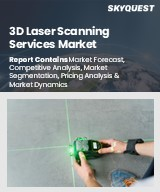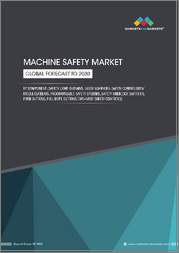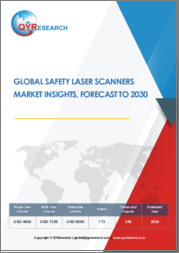
|
시장보고서
상품코드
1838274
3D 레이저 스캐닝 서비스 시장 규모, 점유율, 성장 분석, 서비스별, 기술별, 산업별, 최종사용자별, 지역별 - 산업 예측(2025-2032년)3D Laser Scanning Services Market Size, Share, and Growth Analysis, By Service (Surveying Services, Modeling Services), By Technology, By Industry, By End User, By Region - Industry Forecast 2025-2032 |
||||||
3D 레이저 스캐닝 서비스 세계 시장 규모는 2023년 28억 달러, 2024년 32억 4,000만 달러에서 2032년에는 103억 2,000만 달러에 이르고, 예측 기간(2025-2032년)에 CAGR 15.6%로 성장할 전망입니다.
3D 레이저 스캐닝 서비스 시장은 건설 및 다양한 산업 분야의 정밀도에 대한 요구가 증가함에 따라 크게 성장하고 있습니다. 건설사들은 인프라 계획, 설계, 모니터링을 위해 정확한 데이터를 요구하고 있으며, 이러한 서비스와 디지털 트윈의 통합은 새로운 기회를 제공합니다. 또한, 석유 및 가스, 자동차, 항공우주, 제조업 등의 분야에서 3D 레이저 스캐닝은 자산 관리, 수리, 품질 검사에 활용되어 서비스 제공업체의 수익을 증대시키고 있습니다. 문화유산의 보호는 사적지의 문서화 및 보존을 위해 이 기술의 혜택을 받고 있습니다. 그러나 높은 초기 설비 비용, 숙련된 인력 부족, 데이터 보안 우려 등의 문제가 향후 시장 침투에 걸림돌이 될 수 있습니다. 스캐닝 기술의 지속적인 발전이 앞으로의 성장을 견인할 것으로 보입니다.
자주 묻는 질문
목차
서론
- 조사 목적
- 조사 범위
- 정의
조사 방법
- 정보 조달
- 2차와 1차 데이터 방법
- 시장 규모 예측
- 시장 전제조건과 제한
주요 요약
- 세계 시장 전망
- 공급과 수요 동향 분석
- 부문별 기회 분석
시장 역학과 전망
- 시장 개요
- 시장 규모
- 시장 역학
- 성장 촉진요인과 기회
- 성장 억제요인과 과제
- Porter의 Five Forces 분석
주요 시장 인사이트
- 중요 성공 요인
- 경쟁 정도
- 주요 투자 기회
- 시장 생태계
- 시장의 매력 지수(2024년)
- PESTEL 분석
- 거시경제 지표
- 밸류체인 분석
- 가격 분석
3D 레이저 스캐닝 서비스 시장 규모 : 서비스별&CAGR(2025-2032)
- 시장 개요
- 측량 서비스
- 모델링 서비스
- 컨설팅 서비스
- 데이터 처리 서비스
- 트레이닝 및 지원 서비스
3D 레이저 스캐닝 서비스 시장 규모 : 기술별&CAGR(2025-2032)
- 시장 개요
- 위상 시프트 스캔
- 비행 시간 스캔
- 삼각 측량 스캔
- 모바일 3D 레이저 스캐너
- 정적 3D 레이저 스캐너
3D 레이저 스캐닝 서비스 시장 규모 : 업계별&CAGR(2025-2032)
- 시장 개요
- 건설
- 항공우주
- 자동차
- 석유 및 가스
- 아키텍처 및 유산
- 광업
3D 레이저 스캐닝 서비스 시장 규모 : 최종사용자별&CAGR(2025-2032)
- 시장 개요
- 건설회사
- 엔지니어링 회사
- 정부기관
- 측량 회사
- 학술기관
3D 레이저 스캐닝 서비스 시장 규모&CAGR(2025-2032)
- 북미
- 미국
- 캐나다
- 유럽
- 독일
- 스페인
- 프랑스
- 영국
- 이탈리아
- 기타 유럽
- 아시아태평양
- 중국
- 인도
- 일본
- 한국
- 기타 아시아태평양
- 라틴아메리카
- 브라질
- 기타 라틴아메리카
- 중동 및 아프리카
- GCC 국가
- 남아프리카공화국
- 기타 중동 및 아프리카
경쟁 정보
- 주요 5개사 비교
- 주요 기업의 시장 포지셔닝(2024년)
- 주요 시장 기업이 채택한 전략
- 최근 시장 동향
- 기업의 시장 점유율 분석(2024년)
- 주요 기업 개요
- 기업 상세
- 제품 포트폴리오 분석
- 기업 부문별 점유율 분석
- 매출 전년대비 비교(2022-2024년)
주요 기업 개요
- TruePoint Laser Scanning(USA)
- Arrival 3D(USA)
- TrueScan 3D(USA)
- Multivista(USA)
- Tangent Solutions(USA)
- Bowman(USA)
- GPRS(Ground Penetrating Radar Systems)(USA)
- Zeiss(Germany)
- Leica Geosystems(Switzerland)
- FARO Technologies(USA)
- Trimble(USA)
- RIEGL(Austria)
- 3D Engineering Solutions(USA)
- Applications 3D(USA)
- 3 Shape(Denmark)
- Ouster(USA)
- Cintoo(France)
- Blickfeld(Germany)
- Tejjy Inc.(USA)
- SIGRAY, Inc.(USA)
결론과 제안
LSH 25.10.22Global 3D Laser Scanning Services Market size was valued at USD 2.8 billion in 2023 and is poised to grow from USD 3.24 billion in 2024 to USD 10.32 billion by 2032, growing at a CAGR of 15.6% during the forecast period (2025-2032).
The market for 3D laser scanning services is witnessing significant growth, fueled by the increasing demand for precision in construction and diverse industrial applications. The integration of these services with digital twins presents new opportunities, as construction firms seek accurate data for infrastructure planning, design, and monitoring. Additionally, sectors such as oil & gas, automotive, aerospace, and manufacturing are utilizing 3D laser scanning for asset management, retrofitting, and quality inspection, driving revenue for service providers. Cultural heritage conservation is benefiting from this technology for the documentation and preservation of historical sites. However, challenges such as high initial equipment costs, a lack of skilled workforce, and data security concerns may hinder market penetration going forward. Continuous advancements in scanning technologies will bolster future growth.
Top-down and bottom-up approaches were used to estimate and validate the size of the Global 3D Laser Scanning Services market and to estimate the size of various other dependent submarkets. The research methodology used to estimate the market size includes the following details: The key players in the market were identified through secondary research, and their market shares in the respective regions were determined through primary and secondary research. This entire procedure includes the study of the annual and financial reports of the top market players and extensive interviews for key insights from industry leaders such as CEOs, VPs, directors, and marketing executives. All percentage shares split, and breakdowns were determined using secondary sources and verified through Primary sources. All possible parameters that affect the markets covered in this research study have been accounted for, viewed in extensive detail, verified through primary research, and analyzed to get the final quantitative and qualitative data.
Global 3D Laser Scanning Services Market Segments Analysis
Global 3D Laser Scanning Services Market is segmented by Service, Technology, Industry, End User and region. Based on Service, the market is segmented into Surveying Services, Modeling Services, Consultation Services, Data Processing Services and Training and Support Services. Based on Technology, the market is segmented into Phase Shift Scanning, Time of Flight Scanning, Triangulation Scanning, Mobile 3D Laser Scanners and Static 3D Laser Scanners. Based on Industry, the market is segmented into Construction, Aerospace, Automotive, Oil and Gas, Architecture and Heritage and Mining. Based on End User, the market is segmented into Construction Firms, Engineering Firms, Government Agencies, Surveying Companies and Academic Institutions. Based on region, the market is segmented into North America, Europe, Asia Pacific, Latin America and Middle East & Africa.
Driver of the Global 3D Laser Scanning Services Market
The global market for 3D laser scanning services is experiencing significant growth, driven by its widespread adoption in applications such as topographic mapping, mining, and infrastructure development. The capability of LiDAR technology to gather accurate data across extensive terrains, coupled with enhanced geospatial insights, is bolstering the industry's positive outlook. Both governmental and private entities increasingly favor 3D scanning over traditional surveying methods due to its quicker turnaround times and superior accuracy. Consequently, the rising demand for geospatial intelligence is expected to further stimulate the growth of 3D laser scanning services, highlighting its essential role in various sectors.
Restraints in the Global 3D Laser Scanning Services Market
The global 3D laser scanning services market faces significant challenges due to the necessity for specialized expertise in surveying, software operation, and data analysis required to deliver effective services. This demand for skilled professionals is hindered by a deficiency of qualified individuals, which restricts the scalability and growth potential of these services. Additionally, the availability of training programs is often minimal and costly, further obstructing the development of a competent workforce. Consequently, this skills gap leads to project delays, increased service costs, and a sluggish global adoption of 3D laser scanning technologies.
Market Trends of the Global 3D Laser Scanning Services Market
The Global 3D Laser Scanning Services market is witnessing a significant trend towards the integration of drone-based technologies equipped with LiDAR and advanced laser scanning systems. This innovation facilitates efficient and safe data collection in vast, difficult-to-reach, or hazardous areas, thereby minimizing potential risks faced by human surveyors. The growing demand for accurate and rapid surveying solutions across various industries, including construction, architecture, and environmental monitoring, highlights the value of drone-assisted scanning services. As drone technology continues to advance, it is poised to become a critical component of the 3D laser scanning landscape, driving market growth and enhancing service delivery.
Table of Contents
Introduction
- Objectives of the Study
- Scope of the Report
- Definitions
Research Methodology
- Information Procurement
- Secondary & Primary Data Methods
- Market Size Estimation
- Market Assumptions & Limitations
Executive Summary
- Global Market Outlook
- Supply & Demand Trend Analysis
- Segmental Opportunity Analysis
Market Dynamics & Outlook
- Market Overview
- Market Size
- Market Dynamics
- Drivers & Opportunities
- Restraints & Challenges
- Porters Analysis
- Competitive rivalry
- Threat of substitute
- Bargaining power of buyers
- Threat of new entrants
- Bargaining power of suppliers
Key Market Insights
- Key Success Factors
- Degree of Competition
- Top Investment Pockets
- Market Ecosystem
- Market Attractiveness Index, 2024
- PESTEL Analysis
- Macro-Economic Indicators
- Value Chain Analysis
- Pricing Analysis
Global 3D Laser Scanning Services Market Size by Service & CAGR (2025-2032)
- Market Overview
- Surveying Services
- Modeling Services
- Consultation Services
- Data Processing Services
- Training and Support Services
Global 3D Laser Scanning Services Market Size by Technology & CAGR (2025-2032)
- Market Overview
- Phase Shift Scanning
- Time of Flight Scanning
- Triangulation Scanning
- Mobile 3D Laser Scanners
- Static 3D Laser Scanners
Global 3D Laser Scanning Services Market Size by Industry & CAGR (2025-2032)
- Market Overview
- Construction
- Aerospace
- Automotive
- Oil and Gas
- Architecture and Heritage
- Mining
Global 3D Laser Scanning Services Market Size by End User & CAGR (2025-2032)
- Market Overview
- Construction Firms
- Engineering Firms
- Government Agencies
- Surveying Companies
- Academic Institutions
Global 3D Laser Scanning Services Market Size & CAGR (2025-2032)
- North America (Service, Technology, Industry, End User)
- US
- Canada
- Europe (Service, Technology, Industry, End User)
- Germany
- Spain
- France
- UK
- Italy
- Rest of Europe
- Asia Pacific (Service, Technology, Industry, End User)
- China
- India
- Japan
- South Korea
- Rest of Asia-Pacific
- Latin America (Service, Technology, Industry, End User)
- Brazil
- Rest of Latin America
- Middle East & Africa (Service, Technology, Industry, End User)
- GCC Countries
- South Africa
- Rest of Middle East & Africa
Competitive Intelligence
- Top 5 Player Comparison
- Market Positioning of Key Players, 2024
- Strategies Adopted by Key Market Players
- Recent Developments in the Market
- Company Market Share Analysis, 2024
- Company Profiles of All Key Players
- Company Details
- Product Portfolio Analysis
- Company's Segmental Share Analysis
- Revenue Y-O-Y Comparison (2022-2024)
Key Company Profiles
- TruePoint Laser Scanning (USA)
- Company Overview
- Business Segment Overview
- Financial Updates
- Key Developments
- Arrival 3D (USA)
- Company Overview
- Business Segment Overview
- Financial Updates
- Key Developments
- TrueScan 3D (USA)
- Company Overview
- Business Segment Overview
- Financial Updates
- Key Developments
- Multivista (USA)
- Company Overview
- Business Segment Overview
- Financial Updates
- Key Developments
- Tangent Solutions (USA)
- Company Overview
- Business Segment Overview
- Financial Updates
- Key Developments
- Bowman (USA)
- Company Overview
- Business Segment Overview
- Financial Updates
- Key Developments
- GPRS (Ground Penetrating Radar Systems) (USA)
- Company Overview
- Business Segment Overview
- Financial Updates
- Key Developments
- Zeiss (Germany)
- Company Overview
- Business Segment Overview
- Financial Updates
- Key Developments
- Leica Geosystems (Switzerland)
- Company Overview
- Business Segment Overview
- Financial Updates
- Key Developments
- FARO Technologies (USA)
- Company Overview
- Business Segment Overview
- Financial Updates
- Key Developments
- Trimble (USA)
- Company Overview
- Business Segment Overview
- Financial Updates
- Key Developments
- RIEGL (Austria)
- Company Overview
- Business Segment Overview
- Financial Updates
- Key Developments
- 3D Engineering Solutions (USA)
- Company Overview
- Business Segment Overview
- Financial Updates
- Key Developments
- Applications 3D (USA)
- Company Overview
- Business Segment Overview
- Financial Updates
- Key Developments
- 3Shape (Denmark)
- Company Overview
- Business Segment Overview
- Financial Updates
- Key Developments
- Ouster (USA)
- Company Overview
- Business Segment Overview
- Financial Updates
- Key Developments
- Cintoo (France)
- Company Overview
- Business Segment Overview
- Financial Updates
- Key Developments
- Blickfeld (Germany)
- Company Overview
- Business Segment Overview
- Financial Updates
- Key Developments
- Tejjy Inc. (USA)
- Company Overview
- Business Segment Overview
- Financial Updates
- Key Developments
- SIGRAY, Inc. (USA)
- Company Overview
- Business Segment Overview
- Financial Updates
- Key Developments



















